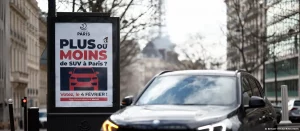Inspiring stories at LIFT09
Designer Matt Webb talked about the relationship between science-fiction and design, followed by Joerg Jelden, a trend analyst from Trend Buero who addressed the importance of fake products and services in the near future. Web veteran James Gillies told us his perspective on the history of the Web, and new media artist Natalie Jeremijenko discussed the opportunity for social and environmental change that new technologies provide.
Note: this post contains embedded video which might now not show up in your rss feed.
Matt Webb
(Note that the picture above does not show Matt Web, but the video does.)
Matt Webb (blog) is a principal of the design shop Schulze & Webb, which has a special focus on the social life of stuff. Projects include material prototypes for Nokia, Web strategy for the BBC, and an electronic puppet that brings you closer to your friends. Matt tinkers with short fiction and web toys, speaks on design and technology, is co-author of acclaimed book Mind Hacks – cognitive psychology for a general audience – and if you were to sum up his design interests in one word, it would be “politeness.”
Matt talked about scientific fiction and design. He starts from a book called World War Z, the 21st Century best zombie novel so far. When you read it, it makes scientific sense. It is believable.
Despite the outlandishness of some science fiction novels, what has held constant is believability, plausibility.
In a scientific fiction, there are three things that have to work together: human nature, society and things.
You can see the same things in physics: pressure, temperature and volume are intimately linked in water.
Scientific fiction explores the chart of possible worlds in the future. You can’t just invent a product and expect that things will change. Society and human nature will have to change too.
Which products are going to work in the landscape of possible worlds?
Market research is one solution. Economics is another. Evolution is another such way of exploring the chart of possible worlds.
This kind of evolutionary thinking was implemented in the iterative design process to create Olinda, a prototype social digital radio Schulze & Webb developed for the BBC.
The radio then evolves into a number of prototypes and ended up “in where we ended up”.
The past is another set of possible worlds, and just as hard to read. Matt focuses on counterfactuals: “what if?”. Popper says it like this: “try to imagine the conditions under which the trends of the history in question would disappear.”
It is manifest in the counterfactual mobile phones, a project done for Nokia in 2005, which melts at 47 degrees Celsius. What is it about the mobile phone despite this violent evolution into different forms? That brought about an exploration about fabrics and phones, and the possibilities of “editing” your phone, thus creating the much-desired value of “greater attachment”.
For Matt, “design is a way of walking over the landscape of possible worlds.”
Joerg Jelden
Joerg Jelden (blog) is a senior trend analyst at Trendbuero – Consultancy for Social Change, in Hamburg and Beijing. At Trendbuero, Joerg advises companies like eBay, Deutsche Post, O2, OTTO or ECCO about the opportunities of social change. His main field of interest is centered around Network Economy: How will the rise of the internet change our society? How will consumer behavior change? How will we do business tomorrow? What will be new business models to answer the changes?
During his stay at Trendbuero’s Asia-Pacific office in Beijing Joerg examined The Future of Fake or “Fakesumption”. He tried to find out, why fakes are so successful, what they do differently and what brands can learn from the fake industry. The project will be published in early 2009 and he gave a preview at LIFT.
Joerg started off with a history of fakes, some insights on a survey they did on how Germans feel about fakes, and a description of the fakes industry in 2009.
So, what can we learn from their success stories? (Fake creators)
1. Consumers: fake delivers something to consumers that the originals don’t, but still these consumers consider themselves to be brand customers. To spy on, sue or punish these consumers might not be the best idea. Are there new ways of integrating customers rather than outlawing them? Can we give consumers a convincing reason to spend much more for the original?
2. Brands: fakes truly explose the brand gap. Companies overvalue brands, brands overestimate themselves. But consumers aren’t buying it. Trust in brands has decreased by 50 percent in the last fifty years. Brands focus too much on products, but what makes the difference is strong relations. One way to deal with this is a better bonding.
3. Fakers: The originals look at the fakes, are inspired by the fakes. Yet fakers attack brands from within. They convert originals into fakes. They sell fake parts to manufacturers, mix fakes with originals and open up online stores to sell directly. So the originals can’t find the fakes anymore. Why don’t brands collaborate with their best fakers? In other words, the way we deal with fakes might need a reconsideration.
James Gillies
James Gillies is the head of communication at CERN. In 2000, he published a book with Robert Cailliau, Tim Berners-Lee’s first partner on the Web project, giving a history of the internet seen through CERN eyes. The fact that the Web was invented at CERN “is no accident”.
James was asked to write the story about the history of the web, when he started working at CERN in 1995.
His presentation, which is best viewed on video, goes through some of the main historical founders — Vannevar Bush (who in July 1945 wrote about the Memex machine), Donald Davies (who developed the concept of packet switching), and Louis Pouzin (who was commissioned by France’s national research network INRIA to build the first internet).
So where does CERN to fit in? It is and has always been a very open place and a research place. In the early 80’s, the Internet was already in place.
Tim Berners-Lee came to work at CERN in 1980 as a consultant to computerise the control system for the particle accelerator. He noticed that none of the programmes could talk with one another. So he wrote a paper that argued that the internet should be an emulation on a computer platform the way that our brains work. He then left CERN and came back in 1989 to implement his vision. By Christmas 1990 he had the web up and running. It only ran on Next and allowed a collaborative flow. Tim always saw the web as a collaborative tool, not as a one-way flow of information.
Then there were a series of developments (the first browser, the first server outside of Europe in 1991, and the pick-up of the web’s commercial potential in 1994).
What was probably the most significant thing that CERN institutionally could have done for the web, happened on 30 April 1993. The web was put in the public domain through the issue of a legal document.
James is absolutely convinced that this single act is the only reason why we have a single web, and not an Apple web, a Microsoft web, etcetera. Another main factor was that all the people James interviewed were altruists in the best sense of the world. In the words of Tim Berners-Lee: “It’s not always what you get out of society, but what you put in.”
Natalie Jeremijenko
(Note that the video stops a few minutes early, which is a pity.)
Natalie Jeremijenko is a new media artist who works at the intersection of contemporary art, science, and engineering. Her work takes the form of large-scale public art works, tangible media installations, single channel tapes, and critical writing. It investigates the theme of the transformative potential of new technologies—particularly information technologies. Specific issues addressed in her work include information politics, the examination and development of new modes of particulation in the production of knowledge, tangible media, and distributed (or ubiquitous) computing elements.
Natalie, who started her career at the computer science labs of Xerox Park, has always been concerned with the question what the opportunities for change are that new technologies represent and how might we seize that to build the kind of social change that we want.
She introduces the audience to a future where environmental issues are “no longer out there” but right here, in our cities and houses. It is a future where global media and global discourse has crumbled.
Whereas environmentalism used to be driven by the “sue the polluter” approach, now the biggest polluters of an urban centre are you and me (because of the city’s many impermeable services).
Natalie then introduced us to a different strategy in the light of this transformed environmental discourse. An example is the environmental health clinic which is in the East River, and thereby externalises health (as health is not only internal and pharmaceutical, but external and something that can be shared).
Another strategy are the pet tadpoles — named after local bureaucrats whose decisions affect water quality — a species which is very sensitive to industrial contaminants.
Finally, she showed the mouse trap that self-administers anti depressants.





[…] Putting People First Designer Matt Webb talked about the relationship between science-fiction and design, followed by […]